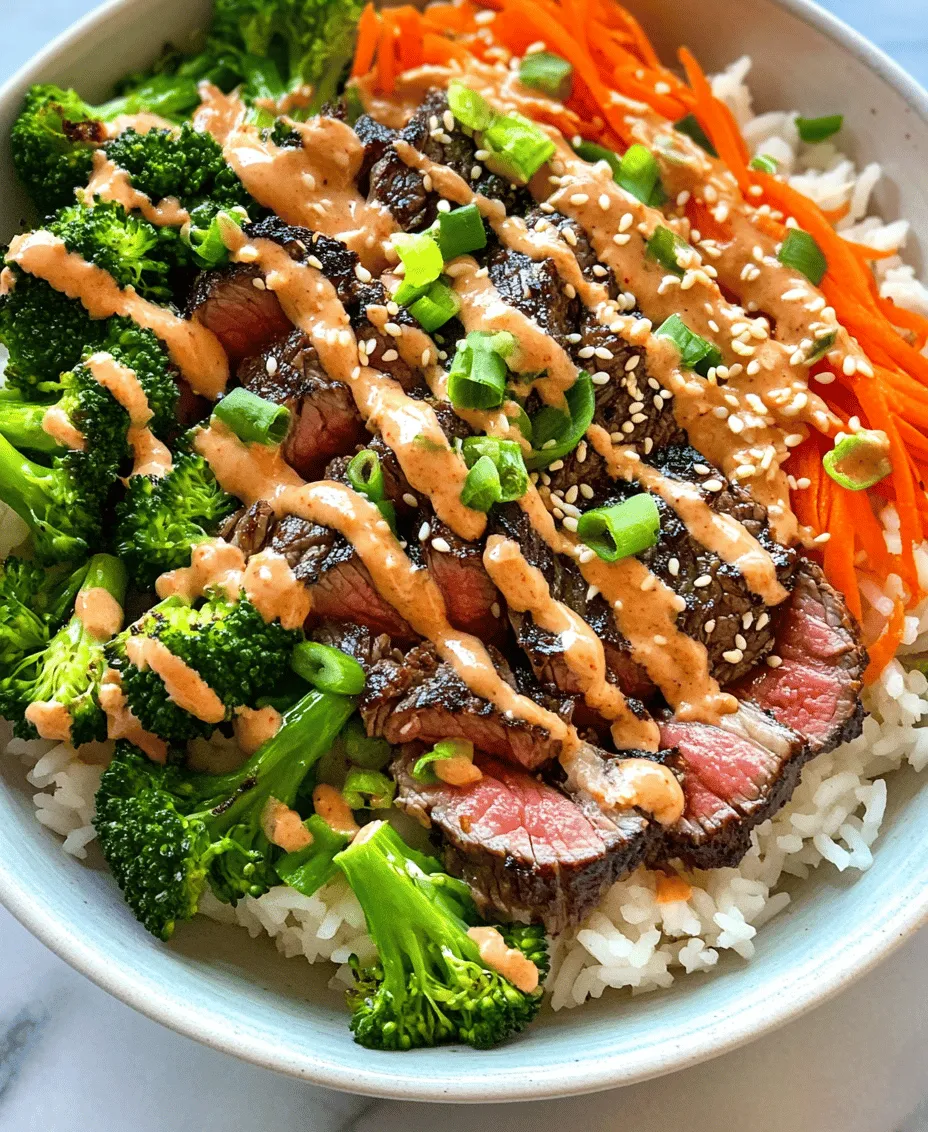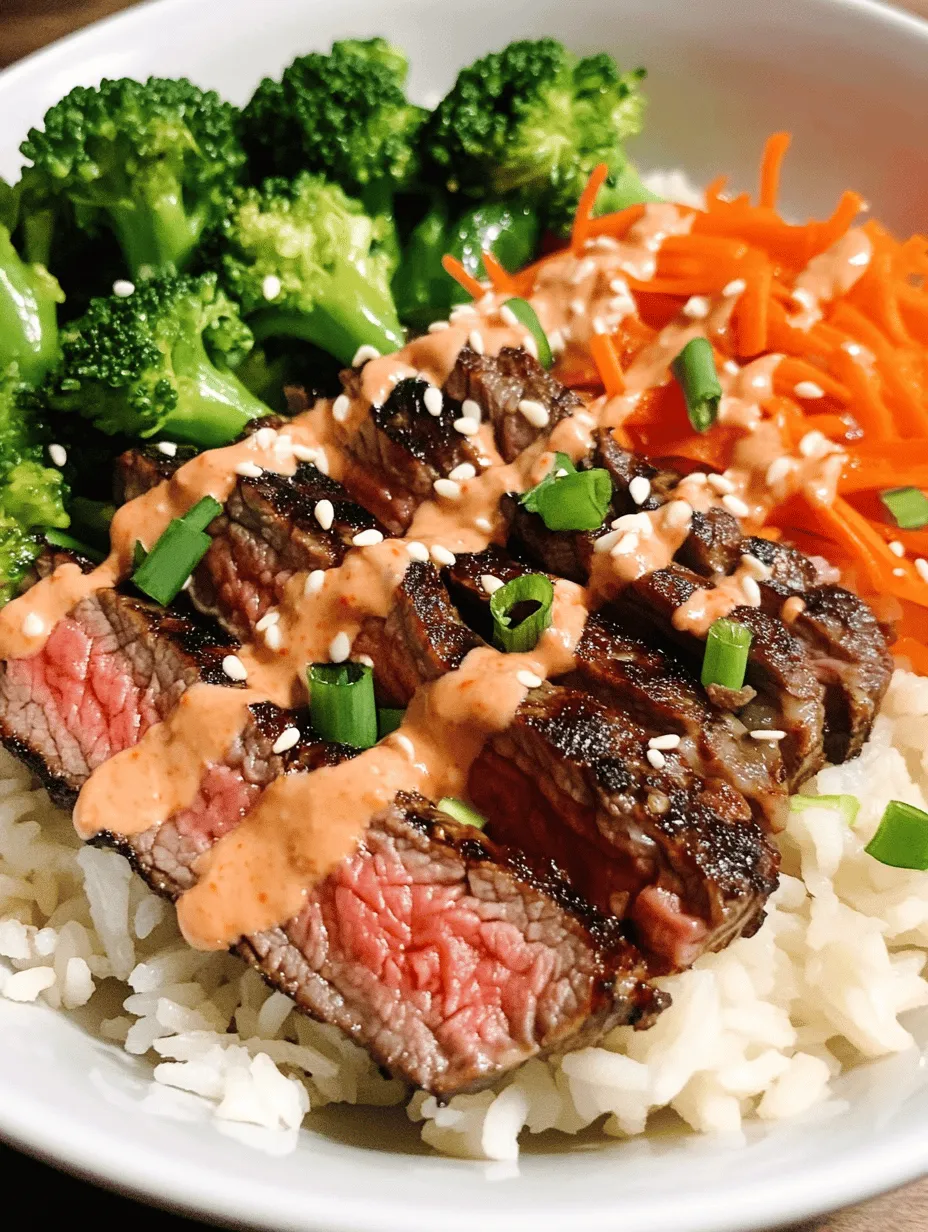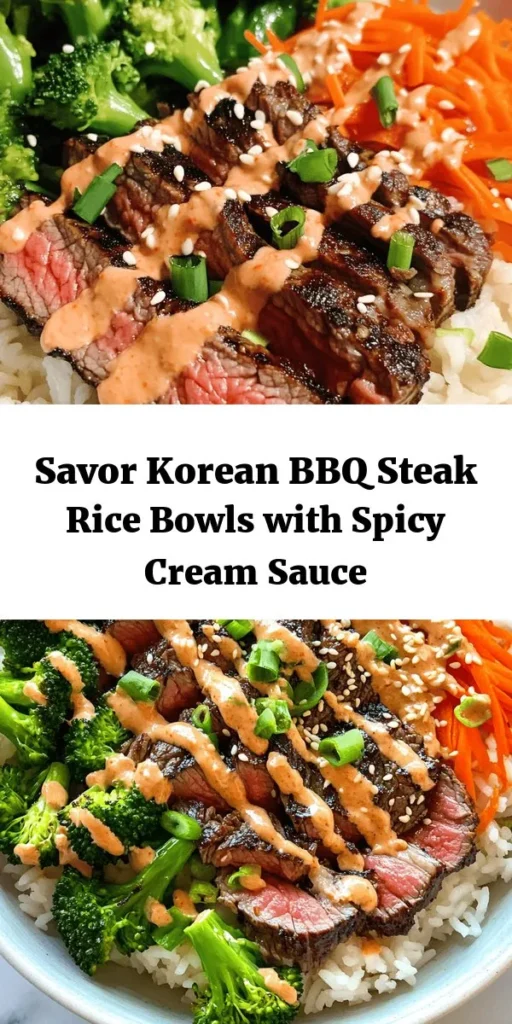Korean cuisine has taken the culinary world by storm, captivating food lovers with its bold flavors, vibrant colors, and unique combinations of textures. Among the standout dishes, Korean BBQ remains a favorite, providing an interactive dining experience that encourages sharing and enjoyment. One of the most delightful ways to enjoy this beloved cuisine is through Korean BBQ steak rice bowls, which offer a harmonious blend of savory marinated steak, fragrant rice, and an array of colorful vegetables. This dish not only tantalizes the taste buds but also packs a nutritional punch, making it an excellent choice for meal prep or family dinners.
At the heart of these rice bowls is the star ingredient: flank steak, which is marinated to perfection before being seared to create a caramelized exterior that seals in its juices. Paired with a fragrant jasmine rice base and fresh vegetables like broccoli, carrots, and green onions, these bowls deliver a satisfying and wholesome meal. However, what truly elevates this dish is the unique spicy cream sauce — a creamy, spicy concoction that adds a delightful kick and transforms the rice bowl into a flavor-packed experience.
Understanding the Key Ingredients
To create the perfect Korean BBQ steak rice bowl, it’s essential to understand the key ingredients that work in harmony to produce a balanced and delicious meal.
Flank Steak
Flank steak is the ideal cut of meat for this recipe due to its tenderness and rich flavor. Known for its pronounced grain and lean composition, flank steak is perfect for marinating, allowing the flavors to penetrate deeply into the meat. When cooked correctly, it becomes incredibly tender and juicy, making each bite a savory delight. This cut is also relatively affordable compared to other steak options, making it a great choice for home cooks looking to create a restaurant-quality meal without breaking the bank.
Marinade Ingredients
The marinade is a crucial component that infuses the flank steak with depth and umami flavors. A traditional Korean BBQ marinade includes:
– Soy Sauce: This savory staple provides the essential salty flavor that enhances the overall taste of the steak.
– Brown Sugar: The sweetness of brown sugar balances the saltiness of the soy sauce and helps to caramelize the meat during cooking.
– Garlic and Ginger: These aromatics add a fragrant depth, contributing to the dish’s signature flavor profile.
– Sesame Oil: A drizzle of sesame oil imparts a nutty richness that complements the marinade beautifully.
– Rice Vinegar: This ingredient adds a touch of acidity, brightening the flavors and tenderizing the meat.
Together, these ingredients create a marinade that not only enhances the flavor of the steak but also tenderizes it, ensuring a delicious result.
Rice Base
The rice base is just as important as the steak itself in these rice bowls. For this recipe, jasmine rice is the recommended choice due to its fragrant aroma and fluffy texture. When cooked, jasmine rice has a slightly sticky quality that helps to hold the dish together, making it easy to enjoy every bite. Moreover, jasmine rice pairs beautifully with the savory flavors of the marinated steak and the spicy cream sauce, creating a well-rounded meal that is both satisfying and delicious.
Vegetable Additions
No rice bowl is complete without a colorful medley of vegetables. In this recipe, fresh broccoli, crunchy carrots, and vibrant green onions not only add nutritional value but also contribute important textures and flavors. Broccoli is rich in vitamins and minerals, while carrots provide a natural sweetness and a delightful crunch. Green onions, on the other hand, add a fresh, oniony bite that brightens the entire dish. Together, these vegetables create a visually appealing and nutrient-dense bowl that elevates the overall dining experience.
Spicy Cream Sauce
The pièce de résistance of these Korean BBQ steak rice bowls is the spicy cream sauce. This sauce is a game-changer, introducing a creamy texture and a spicy kick that perfectly complements the savory steak and fragrant rice. The sauce typically includes:
– Gochujang: This Korean red chili paste is the primary source of heat in the sauce, providing a complex flavor that is both spicy and slightly sweet.
– Mayonnaise: The creaminess of mayonnaise serves as the base of the sauce, creating a smooth and luscious consistency that balances the heat of the gochujang.
– Lime Juice: A splash of lime juice adds brightness and acidity, helping to cut through the richness of the sauce.
The combination of these ingredients results in a versatile sauce that can be drizzled over the rice bowls or used as a dipping sauce for other dishes, making it a fantastic addition to your culinary repertoire.
Marinating the Flank Steak for Optimal Flavor
Marinating the flank steak is a crucial step in this recipe that cannot be overlooked. The process of marination enhances the flavor and tenderness of the meat, ensuring a delicious outcome.
Benefits of Marinating
Marinating is not only about flavor; it also serves to tenderize the meat. The acidity from the rice vinegar and the enzymes in garlic and ginger work together to break down the tough fibers in the flank steak, resulting in a more tender and juicy final product. Furthermore, marination allows the flavors of the marinade to penetrate deep into the meat, creating a more flavorful dish.
Marination Time
The duration of the marination is critical in determining the intensity of the flavors. For optimal taste, it is recommended to marinate the flank steak for at least 30 minutes, but if time allows, marinating it for several hours or even overnight will yield even better results. A longer marination time allows the flavors to develop more fully, resulting in a richer and more savory steak.
Visual and Textural Changes
During the marination process, the steak will undergo visual and textural changes. Initially, the flank steak will appear bright red, but as it absorbs the marinade, it will take on a deeper, darker hue. Additionally, the meat will become more tender to the touch, indicating that it is ready to be cooked. When you’re ready to grill or sear the steak, be sure to remove it from the marinade and let it come to room temperature for even cooking.
Preparing the Spicy Cream Sauce
While the flank steak marinates, it’s the perfect time to prepare the spicy cream sauce. This sauce is straightforward to make and adds a delightful kick to the rice bowls.
Step-by-Step Instructions
To create the spicy cream sauce, gather the following ingredients: gochujang, mayonnaise, and lime juice. In a small bowl, combine 2 tablespoons of gochujang with 1/2 cup of mayonnaise. Mix well until the two ingredients are thoroughly blended. Next, add the juice of half a lime to the mixture, adjusting the amount to taste. If you prefer a spicier sauce, you can add more gochujang or even a pinch of cayenne pepper for an extra kick.
Adjusting Spiciness
One of the great things about this sauce is its versatility. Feel free to adjust the spiciness to cater to your personal taste. If you’re cooking for a crowd with varying spice tolerances, consider serving the sauce on the side so everyone can customize their bowls according to their preferences.
Uses Beyond the Rice Bowl
This spicy cream sauce is incredibly versatile and can be used in various dishes beyond the rice bowls. Consider using it as a dipping sauce for grilled meats, a spread for sandwiches, or even as a drizzle over roasted vegetables. The possibilities are endless, making it a fantastic addition to your culinary toolkit.
Cooking the Flank Steak to Perfection
Once your flank steak has been marinated and your spicy cream sauce is ready, it’s time to cook the steak to perfection. The cooking method is crucial to achieving that ideal sear while keeping the inside juicy and tender.
(Continue with detailed cooking instructions and tips to follow in the next part of this article.)

Techniques for Cooking Steak to the Desired Doneness
When it comes to achieving the perfect steak for your Korean BBQ rice bowls, mastering cooking techniques is essential. The two popular methods for cooking steak are grilling and pan-searing, each offering unique benefits for flavor and texture.
Grilling vs. Pan-Searing
Grilling is a favorite method for many due to the smoky flavor it imparts. When grilling, ensure your grill is preheated to high heat. This helps to achieve those iconic grill marks and a delicious crust. To grill flank steak effectively:
1. Preheat the Grill: Heat your grill to a high temperature (around 450°F to 500°F).
2. Oil and Season: Brush the steak with oil and season it generously with salt and pepper before placing it on the grill.
3. Cooking Time: For a medium-rare steak, grill for about 4-5 minutes on each side, depending on thickness.
4. Check for Doneness: Use a meat thermometer; the internal temperature should reach 130°F for medium-rare.
Pan-searing is another excellent option, especially in colder seasons or if you don’t have access to an outdoor grill. It allows for precise control over the cooking process:
1. Choose the Right Pan: Use a cast-iron skillet or stainless steel pan for the best sear.
2. Heat the Pan: Preheat the pan over medium-high heat until it’s hot, then add a small amount of oil.
3. Sear the Steak: Place the steak in the pan and do not move it for 3-4 minutes to develop a crust. Flip and sear the other side for another 3-4 minutes.
4. Monitor Temperature: Similar to grilling, use a meat thermometer to check for doneness.
Temperature Guidelines
Understanding cooking times based on steak thickness and desired doneness is fundamental to perfecting your steak. Here’s a quick reference:
– Rare (120°F): 2-3 minutes per side.
– Medium-Rare (130°F): 3-4 minutes per side.
– Medium (140°F): 4-5 minutes per side.
– Medium-Well (150°F): 5-6 minutes per side.
– Well-Done (160°F): 6-7 minutes per side.
Keep in mind that cooking times can vary based on the thickness of the steak, so using a meat thermometer is the most reliable method to achieve the desired doneness.
Resting the Steak
After cooking, let your steak rest for at least 5-10 minutes before slicing. This step is crucial as it allows the juices to redistribute throughout the meat, resulting in a tender, juicy steak. If you slice immediately, the juices will run out, leading to a drier result.
Assembling the Rice Bowls
Now that your steak is perfectly cooked, it’s time to assemble your Korean BBQ steak rice bowls. Presentation plays a significant role in enhancing the overall dining experience.
Layering Techniques
When assembling your rice bowls, think about layering ingredients for both aesthetics and flavor. Start with a base of fluffy white rice or brown rice, then add the sliced steak on top. Next, include a generous portion of sautéed or steamed vegetables, such as broccoli and carrots. Layering not only looks appealing but also allows for the flavors to mingle as you eat.
1. Base Layer: Begin with a scoop of rice. The rice serves as a neutral base that absorbs the flavors of the steak and sauce.
2. Steak Placement: Arrange the sliced steak neatly on top of the rice. The presentation will entice your guests, making the dish visually appealing.
3. Vegetable Addition: Add colorful vegetables around the steak. This adds vibrancy and freshness to the dish.
Balancing Flavors and Textures
A well-balanced meal is key to a satisfying dining experience. The rich, savory flavor of the steak should be complemented by the fresh crunch of vegetables and the creamy texture of the spicy sauce. When assembling your bowl, consider the following:
– Flavor Profiles: The umami-rich marinade from the steak pairs beautifully with the crunch of fresh vegetables, creating a harmonious dish.
– Texture Variety: Aim for contrasting textures; the tenderness of the steak, the crispness of the vegetables, and the creaminess of the sauce create a delightful mouthfeel.
Garnishing for Flavor
Garnishing is more than just aesthetic; it adds flavor and texture enhancements. Top your rice bowls with:
– Chopped Green Onions: Their mild onion flavor adds freshness to the dish.
– Sesame Seeds: Toasted sesame seeds provide a nutty flavor and a pleasant crunch.
– Chili Flakes: If you prefer an extra kick, sprinkle some chili flakes on top for added heat.
Nutritional Benefits of Korean BBQ Steak Rice Bowls
These rice bowls are not only delicious but also packed with nutritional goodness.
Protein Content
Flank steak is a fantastic source of high-quality protein, which is essential for muscle growth and repair. A 3-ounce serving of flank steak contains approximately 23 grams of protein, making it an ideal option for those looking to maintain a healthy diet.
Vegetable Contributions
Incorporating a variety of vegetables, such as broccoli and carrots, enhances the nutritional profile of your dish:
– Broccoli: Rich in vitamins C and K, fiber, and antioxidants, broccoli supports immune health and contributes to overall well-being.
– Carrots: These vibrant vegetables are loaded with beta-carotene, which is converted to vitamin A in the body, promoting good vision and skin health.
Balanced Meal
Korean BBQ steak rice bowls offer a balanced meal that includes protein, complex carbohydrates from the rice, and a variety of vitamins and minerals from the vegetables. This combination ensures you are fueling your body with the right nutrients, making it a satisfying and healthy option for lunch or dinner.
Cultural Significance of Korean BBQ
Korean BBQ is not just a way of cooking; it represents a significant aspect of Korean culture and tradition.
History and Tradition
The origins of Korean BBQ can be traced back to the Goguryeo era (37 BC – 668 AD), where people grilled meat over open flames. Over the centuries, the tradition evolved, becoming a social event where family and friends gather around a grill to enjoy not only the food but also each other’s company. BBQ restaurants are a staple in Korea, with diners often grilling their meat at the table, creating an interactive dining experience.
Modern Interpretations
In recent years, Korean BBQ has gained immense popularity around the world, adapting to various culinary preferences. Home cooks are now embracing these traditional flavors by creating Korean BBQ-inspired dishes, like the steak rice bowls. This dish not only pays homage to its roots but reflects the globalization of cuisine, allowing everyone to appreciate the vibrant flavors of Korean cooking.
Conclusion: Enjoying Your Korean BBQ Steak Rice Bowls
Korean BBQ steak rice bowls are a flavorful, nutritious, and visually appealing meal that embodies the essence of Korean cuisine. From the perfectly cooked steak to the fresh vegetables and spicy cream sauce, each element contributes to a delightful dining experience.
By following the detailed cooking techniques, assembly tips, and understanding the nutritional benefits, you can create a bowl that not only satisfies your taste buds but also nourishes your body. Embrace the rich culinary heritage of Korean BBQ and enjoy sharing this dish with family and friends, celebrating the flavors that have traveled across generations and borders.
As you prepare and indulge in your Korean BBQ steak rice bowls, reflect on the cultural significance behind this dish and let it inspire your culinary journey. Happy cooking!



